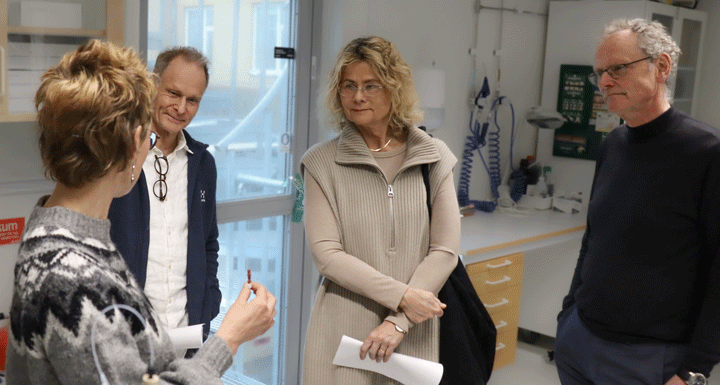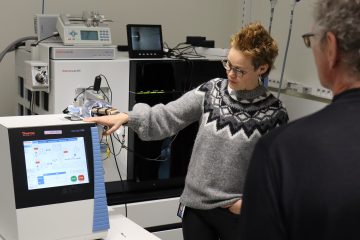
COLUMN. The Faculty Management has now conducted its annual visits to all institutes and Core Facilities. In her latest column, Dean Agneta Holmäng describes the fruitful discussions she had during her visits and how impressed she was by both research and education in the institutes.
The annual tour of our institutes and Core Facilities is an important tradition for members of the Faculty Management. It gives us the opportunity to learn about their work and to have a fruitful discussion about pressing issues for the organizations. We especially enjoyed it this year because the pandemic has prevented these in-person visits for so long.
Create the best possible conditions for all staff

The visits made me both happy and proud about the education and research taking place at our institutes. Environmental efforts and “climate footprints” were also discussed within the climate framework the University has adopted. During the visit to the Institute of Clinical Sciences, for example, we had the opportunity to see the clinical trials unit at oncology and radiation therapy, and at the Institute of Biomedicine we listened to presentations by some of the institute’s successful and talented young researchers.
As dean, I am charged with creating the best possible conditions for all staff to enable them to do the best job possible. Our visits highlighted two important issues, in particular, that Faculty Management has been working on for a long time, but which now need to be resolved as soon as possible.
One underscores the need to quickly obtain secure research data storage for sensitive personal data with a high security classification. The Faculty has brought this to the attention of the Vice-Chancellor, who is now appointing a workgroup to develop a prototype for a secure database, together with the University’s information technology staff. In a pilot project, some researchers from all institutes at Sahlgrenska Academy have now been invited to test this database. We would especially like to thank Max Petzold, Elisabet Carlsohn, and Per Sikora for their active involvement in this effort. We hope to have a functioning and secure database before the end of the year to offer all our researchers.
Now a major process is underway to agree on a single profile area
The second issue is of great importance to the Faculty and involves developing a proposal for profile areas. The Government has decided that all higher education institutions are to apply for these to the Swedish Research Council. This model will serve as a tool for allocating increased direct research funding to higher education institutions. The model is intended to replace the current quality indicator-based resource allocation model, with a planned introduction beginning in 2024.
In the university-wide process led by the Research Board, the faculties will be allowed to propose profile areas. Starting on June 1, the research funding bodies will release details about the application. Within the faculties we have begun working to reach an agreement on an area that is competitive, with high quality and that is broadly based, so that as much of our research as possible can be included. The departments have nominated participants for a workgroup that includes Vice-Dean for Research Lena Carlsson Ekander. Since the quality of collaboration is an important aspect in the external assessment, we have asked AstraZeneca to propose a representative to serve on the workgroup.
Good potential for success in competition with other applicants
We have also started preparing for the major calls for proposals within Data Driven Life Science (DDLS), which is funded by the Knut and Alice Wallenberg Foundation. Christina Jern is the Director of the Wallenberg Center for Molecular and Translational Medicine (WCMTM). She is leading the discussions that will result in goals and strategies to ensure that we have the best potential for success in competition for these large funds, which will be distributed among higher education institutions over a period of 12 years.
Research infrastructure is important
All platforms within our Core Facilities are national infrastructures. This is a form of quality assurance that we are very proud and happy about. Gothenburg is also a node in SciLifeLab, which is considered part of the national infrastructure. This infrastructure offers advanced technology and expertise to researchers throughout Sweden. Unfortunately, we have noted very low level of utilization of the infrastructure by our researchers. Hoping to increase its use, in the autumn the Faculty will be working with the Core Facility to disseminate information about SciLifeLab.
Research infrastructure is important. There is currently a proposal to allow the Vice-Chancellor to finance 10 percent of the cost for the University’s research infrastructures to provide long-term capital for basic infrastructure. We favor the proposal, but it is important for this to be clearly defined, maintain high quality, and to apply user fees so that we can monitor the utilization rate. We also want to include the University Library, at least those parts used for research.
One unresolved question that is now being addressed is the possibility for associate senior lecturers to be appointed to combined positions. After meetings with the University’s Human Resources department, it has been decided that the University Board will consider this matter in the autumn, since the appointments procedure must be revised before combined positions can be allowed. It is important to make this opportunity available to young clinical researchers so that they can better plan their careers.
I hope you will have the opportunity to attend the lecture by Bo Håkansson
Bo Håkansson, professor of electrical engineering at Chalmers University of Technology, was appointed an honorary doctor at Sahlgrenska Academy two years ago, but the conferment had to be postponed due to the pandemic. Now we are finally able to recognize his appointment properly. I hope you have the opportunity to attend the Bo Håkansson’s lecture in the Arvid Carlsson lecture hall on Wednesday, May 4 at 4:00 pm. This will be a unique opportunity to hear more about his world-class research on sound waves in human bone, which has led to the bone-anchored hearing aids that have had a life-altering impact on people with impaired hearing. Personally, I’m looking forward to this interesting lecture and the opportunity to show our appreciation for his importance for collaboration with the faculty. Both the development of research on the propagation of sound waves in human bones and of intention-driven hand movements in arm prostheses have attracted great international attention.
This autumn, on October 26, we will also have the opportunity to hear 2021 Honorary Doctor Carolina Klüft in connection with Sports Research Day, which will be held in the Vasaparken auditorium.
Enjoy the spring!
Agneta Holmäng










